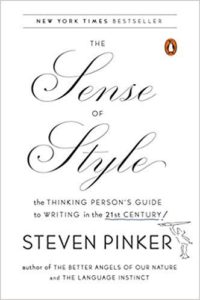 Every day we use words to communicate, in voice, letters, emails, reports, and even tweets. But do others really understand us?
Every day we use words to communicate, in voice, letters, emails, reports, and even tweets. But do others really understand us?
Perhaps it is time to refresh our use of the English language. Steven Pinker, a renowned Harvard professor and author, suggests “the effective use of words to engage the human mind” (my italics), in his latest book.
“Style still matters,” he argues. It gets messages across, earns trust, and, perhaps most important, adds beauty to the world. We need to develop our “instinct for language,” coming from both reading and conversation, avoiding both the overly rigid rules of semanticists and simultaneously, the confusing colloquialisms of day-to-day communication. Trash such as “like” and “you know”!
Pinker is an engaging writer. He begins by recommending a re-read of three earlier commentators on language: William Strunk and E. B. White’s immortal The Elements of Style (1959), Henry Fowler’s Modern English Usage (1926), and Theodore Bernstein’s The Careful Writer (1968).
But Pinker moves on from those writers, as does our language. Today, he cites the common problems of overuse of jargon, abbreviations, and technical vocabulary. He reminds us of Strunk and White’s repeated urging for simplicity. Avoid passive sentences and lengthy phrases. Use the active sense. Be brief. Paragraph breaks: not too many and not too few. Avoid the “prissy use of quotation marks.”
One writer’s problem today is how to avoid the overuse of masculine nouns, when we are cautioned to use feminine or neuter. Pinker follows his own advice, alternating in each chapter, using masculine first as the object and then the subject, then the feminine, avoiding altogether the ugly and confusing neuter words.
For many years, I’ve followed the counsel of Occam’s Razor (the simpler answer may be correct). Pinker introduces Hanlon’s Razor: “Never attribute to malice that which is adequately explained by stupidity.” I’ll use this in my next critique of politicians.
Pinker meanders a bit in his chapters on diagramming sentences (too complex; I prefer my own ear) and coherence (do we really need to understand the wars between prescriptivists and descriptivists?) These chapters are often overly detailed, although rich in examples.
By far his best chapter is his longest (117 pages), “Telling Right From Wrong”. It is a detailed discussion of possibilities, often with no “right” answers. Examples: split infinitives; shall versus will; that and which; who and whom; “very unique”; plus a section on words as seen and used by purists and relativists. How do you define and use decimate; convince; presently (one of my pet peeves); adverse versus averse; bemused; data (singular or plural?); fortuitous; irregardless (ugh!); parameter; tortuous; and the use of serial commas.
More damn fun and Pinker will change your habits. Enjoy stringing words together and above all, be coherent.
Editor’s Note: ‘The Sense of Style’ by Steven Pinker was published by Viking, New York 2014

About the Author: Felix Kloman is a sailor, rower, husband, father, grandfather, retired management consultant and, above all, a curious reader and writer. He’s explored how we as human beings and organizations respond to ever-present uncertainty in two books, ‘Mumpsimus Revisited’ (2005) and ‘The Fantods of Risk’ (2008). A 20-year resident of Lyme, he now writes book reviews, mostly of non-fiction, which explores our minds, our behavior, our politics and our history. But he does throw in a novel here and there. For more than 50 years, he’s put together the 17 syllables that comprise haiku, the traditional Japanese poetry, and now serves as the self-appointed “poet laureate” of Ashlawn Farm Coffee, where he may be seen on Friday mornings. His late wife, Ann, was also a writer, but of mystery novels, all of which begin in a village in midcoast Maine, strangely reminiscent of the town she and her husband visited every summer.